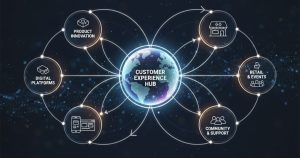Data-Driven Brand Storytelling: Metrics That Matter

Stories capture attention and connect people emotionally, a fact that advertisers and marketers have leveraged for decades. But in today’s digital age, storytelling alone isn’t enough. To create a lasting impact, storytelling must be backed by data. Welcome to the era of data-driven brand storytelling.
If you’re ready to harness the power of metrics to amplify your brand’s message and connect deeply with your audience, this guide is for you. You’ll learn not only what data-driven storytelling is and why it matters but also how to implement metrics that bring your brand story to life.
What Is Data-Driven Brand Storytelling?
At its core, data-driven brand storytelling is about using insights and metrics to craft compelling, relatable stories. It’s the fusion of analytics and creativity. Data informs your content direction, ensuring your stories resonate with your target audience, while creative storytelling helps your audience emotionally connect with the data.
Consider Nike’s powerful campaigns. Their storytelling centers on inspiration and achievement, but they’re fueled by an intricate understanding of customer demographics, sales data, and even behavioral trends. Nike’s data-centric approach ensures every story hits the mark.
Why Data-Driven Brand Storytelling Matters
Storytelling is an art, but with metrics, it becomes measurable, actionable, and scalable. Here’s why adopting a data-driven approach can transform your brand’s communication:
1. Resonates with Your Audience
Using data helps pinpoint your audience’s pain points, preferences, and aspirations. When your stories address these insights, they feel tailor-made for your audience, fostering loyalty and trust.
2. Enhances Content Performance
You can use engagement metrics (click-through rates, dwell time, etc.) to measure how well your narrative performs and adjust accordingly. This ensures continuous improvement in your campaigns.
3. Drives Strategic Decisions
Data-driven storytelling doesn’t just captivate audiences; it provides insights that guide long-term business strategies. Think product development, customer engagement tactics, or market expansion.
4. Sets You Apart from Competitors
It’s no longer enough to tell a good story. Competitors are doing the same thing. A data-driven approach ensures your storytelling is relevant, unique, and harder to replicate.
Metrics That Matter for Data-Driven Storytelling

Not all data is created equal. For storytelling purposes, certain metrics provide more value. Here’s a look at the data points that elevate your narratives:
1. Demographic Data
Understand who your audience is. Age, gender, location, occupation, and lifestyle metrics can help you craft stories that speak directly to your target demographic.
Example Use: A skin-care brand targeting millennials could use data showing that their target audience values sustainability. Their campaigns could focus on their eco-friendly product ingredients.
2. Behavioral Insights
Understand how your audience interacts with your content or products. Behavioral data, such as purchase history or browsing patterns, offers clues about consumer preferences.
Example Use: Spotify analyzes listening habits to create “Spotify Wrapped,” an annual campaign that showcases personalized listening stats, turning data into a celebratory story.
3. Engagement Metrics
Track likes, shares, comments, click-through rates, and video watch times. These metrics can indicate whether your storytelling approaches are engaging your audience.
Action Tip: If engagement is low, assess whether your CTA (Call to Action) is compelling enough or whether the narrative aligns with audience expectations.
4. Sentiment Analysis
Go beyond raw numbers with tools like sentiment analysis that gauge audience feelings. Platforms like MonkeyLearn analyze comments, reviews, and social mentions to measure emotional responses.
Example Use: A product launch video with predominantly positive comments, such as “this is life-changing,” reiterates your story is making an impact.
5. Conversion Data
Track how many customers take desired actions like signing up for newsletters, downloading guides, or purchasing products. These numbers indicate if your storytelling is driving results.
How to Build Your Brand Story with Data

With the right metrics in hand, here’s a step-by-step breakdown of crafting your data-driven story:
1. Define Your Objectives
Start with the end in mind. Are you trying to build awareness, improve engagement, or drive sales? Your metrics should align with your goal.
2. Build Customer Personas
Use demographic and behavioral data to create profiles for your target audience. What motivates them? What problems are they trying to solve? Keep these personas in mind when crafting your message.
3. Leverage Data as a Narrative Foundation
Use specific numbers or trends to frame your story. For example, Nike’s campaign “Dream Crazy” drew on data showing rising youth participation in sports to offer an empowering narrative.
4. Focus on Emotion
Humanize your metrics by weaving them into relatable, emotionally charged stories. People relate to other people or experiences more than numbers alone.
Example: Instead of saying “40% of users love our product,” share a story about how one customer solved a unique problem using your product.
5. Test, Optimize, Repeat
Test different elements of your storytelling, such as headlines, visuals, and delivery platforms. Use A/B testing on headlines or track performance metrics over time to refine your strategy.
Success Stories of Data-Driven Brand Storytelling
Here are examples of brands using data to craft meaningful stories:
1. Airbnb
Airbnb uses user-generated content and booking data to highlight inspiring travel stories. They analyze travel trends and feature listings that connect emotionally while showcasing the diversity of their offerings.
2. LinkedIn
LinkedIn’s annual “Year in Jobs” campaign uses job market data to create captivating narratives for both job seekers and employers.
Transform Your Brand Storytelling Today
Data-driven brand storytelling bridges the gap between creativity and analytics, ensuring every message you send speaks to your audience’s hearts and minds. With the right metrics, you can craft stories that don’t just inspire but also deliver measurable results.
Take the next step in revolutionizing your content strategies. Sign up for our free tools and explore how data can power your storytelling efforts.






